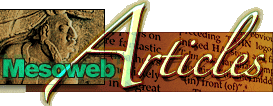
| Note: If you arrived at this page via Mesoweb Search, use your browser's Find feature to locate the text of interest, then click the link to go to the illustrated page. Or click here to go to the beginning of the article. |
|
Go to page: The Spanish Conquistadors, brutal men themselves, were appalled by the bloody human sacrifices of the Aztecs. Rightfully so. The Maya, and the Olmec before them, had equally gruesome rites. Can we hope to understand?
Go to page: Thousands of years ago, the first settled cultures in the Valley of Mexico left evidence of their concern with fertility. Go to page: Female figurines are found in graves at a site called Tlatilco. Many have wide hips suggesting the power to give birth. Go to page: (Narrow eyes are also characteristic, the pupil a single dot from a cactus thorn.) Go to page: Like images of the great goddess from around the world, they reflect the concern of planting cultures with the birth-giving power of "mother" earth. Go to page: These people's shaman told them of a spirit world behind the apparent reality. Birth was an emerging from this world of spirit. Death was a descent back into it. In an unending cycle, the crops died and were born again -- if the spirit world permitted it. Go to page: The surface of the earth was a thin crust between material reality and the real world of spirit. Or, according to the shaman, everything was part of the same life force. (This Olmec impersonater of the feathered serpent god holds a shaman's incense bag.) Go to page: Also in the graves at Tlatilco were masks of human faces with the flesh partly exposed to show the skull underneath. Images of death within life were buried with the female figurine's promise of life within death. Go to page: If the living flesh was the mask of death, then death too might be a mask. Go to page: Just as the dead crops went into the earth, so too did humans when they died. And the skeleton was revealed. Go to page: If the rains came, the crops came back in the unending seasonal cycle. Humans emerged again as babies from the land of the fleshless. Thus skulls and skeletons are symbols of regeneration. And as still seen on the Day of the Dead, the supernatural is natural. Go to page: In Aztec mythology, the underworld was ruled over by its Lord and Lady. It was a gloomy place, reached by the dead only after wandering for years beneath the earth accompanied by a "soul-companion", a dog cremated with the corpse. Go to page: One myth tells how Quetzalcoatl, the feathered serpent god, went to this land of Mictlan. He journeyed in the Fifth Sun in order to restore humankind to life from the bones of those who had lived in the previous four eras. Go to page: For bones are like seeds: everything that dies goes into the earth, and from the earth new life is born in the sacred cycle of existence. Go to page: Quetzalcoatl approached the Lord of Mictlan, where he sat on his throne surrounded by spiders and owls. "I've come for the bones, the precious bones, the jade bones," said Quetzalcoatl. "Can I have them in order to populate the earth?" Go to page: Only unwillingly did the Lord of Mictlan give his assent. "You may take away that which I guard so carefully on one condition -- that you parade four times around my throne blowing on this trumpet." Go to page: And he handed Quetzalcoatl a conch shell that had no finger holes. But worms bored the fingerholes, and bees flew inside to make a sound. Go to page: Even so, Quetzalcoatl knew that he'd better move quickly to take the bones and leave. And sure enough the Lord of Mictlan gave orders that the bones be recovered. Quetzalcoatl thought of a trick. Go to page: "Tell the Lord I'll leave the bones behind," he said to his nahual, his spirit twin. Accordingly the nahual, looking just like Quetzalcoatl himself, assured the Lord of Mictlan that the bones would be left. Meanwhile Quetzalcoatl began to run. Go to page: Unfortunately, the Lord of Mictlan ordered that a pit be dug in the fleeing god's path, and sure enough he fell into it, having been startled by a covey of quail. Go to page: Those bones that weren't already shattered were pecked at by the quail. Which is why humans come in all sizes. Go to page: "This has not worked out well," said Quetzalcoatl to his spirit twin. Go to page: "What must be must be," replied the nahual. And so Quetzalcoatl scooped up the bones and, once safely beyond the dead land, ground them up in a bowl. Go to page: Together with other gods, he sprinkled them with his own blood, restoring them to life. Thus humankind was born from the pennance of the gods themselves. And this gift had to be repaid in the blood of sacrifice. How else could it be, reasoned the ancients. Since the death of vegetation always preceded its regeneration, death must be the cause of life. "Life and Death in Ancient Mexico" is based on The Flayed God: The Mesoamerican Mythological Tradition by Roberta H. and Peter T. Markman. The story of Quetzalcoatl in Mictlan is based on The Myth of the Suns and the Toltec-Chichimec Origins of the Mexica People, as translated by Willard Gingerich. |
![]()